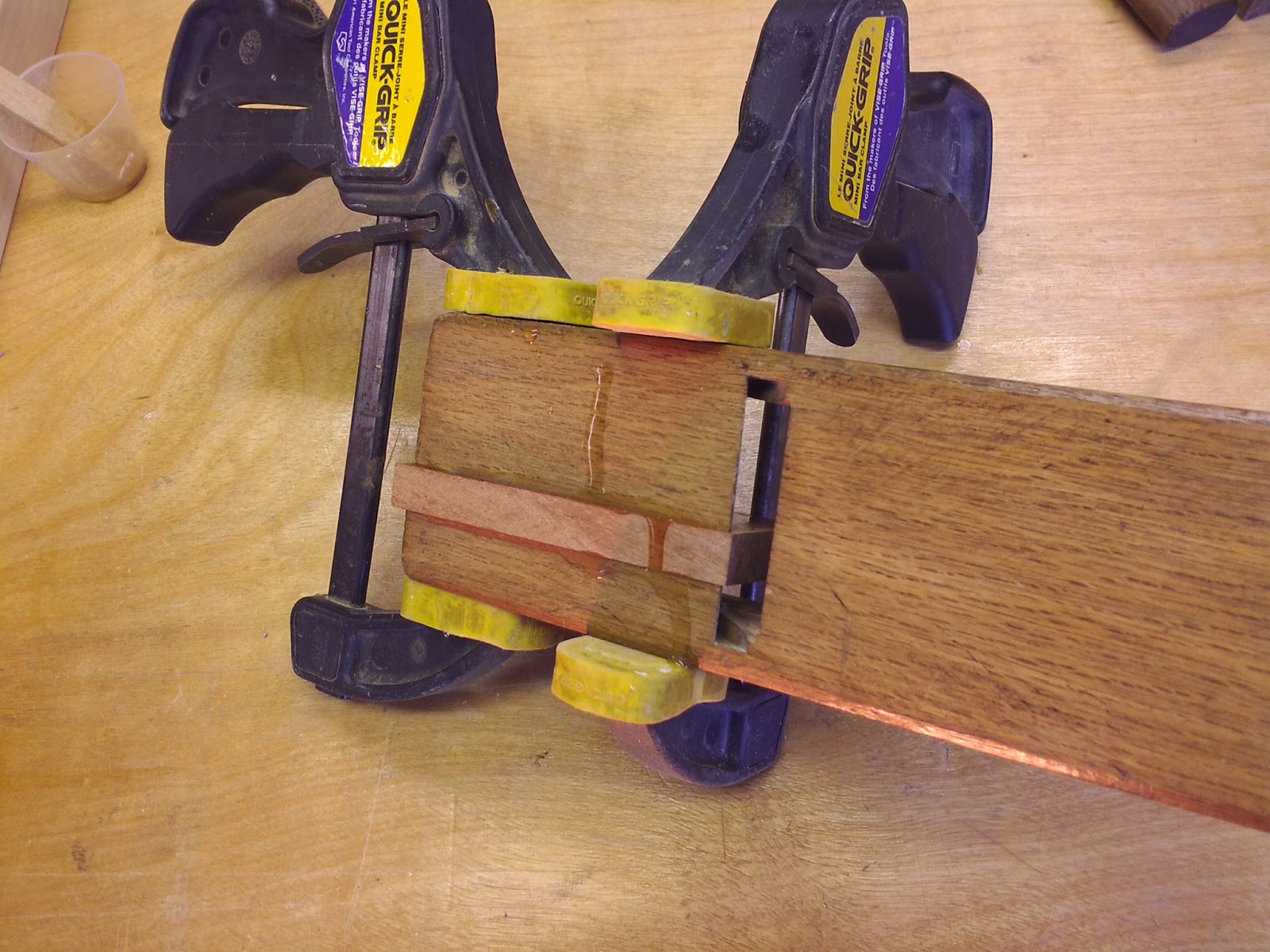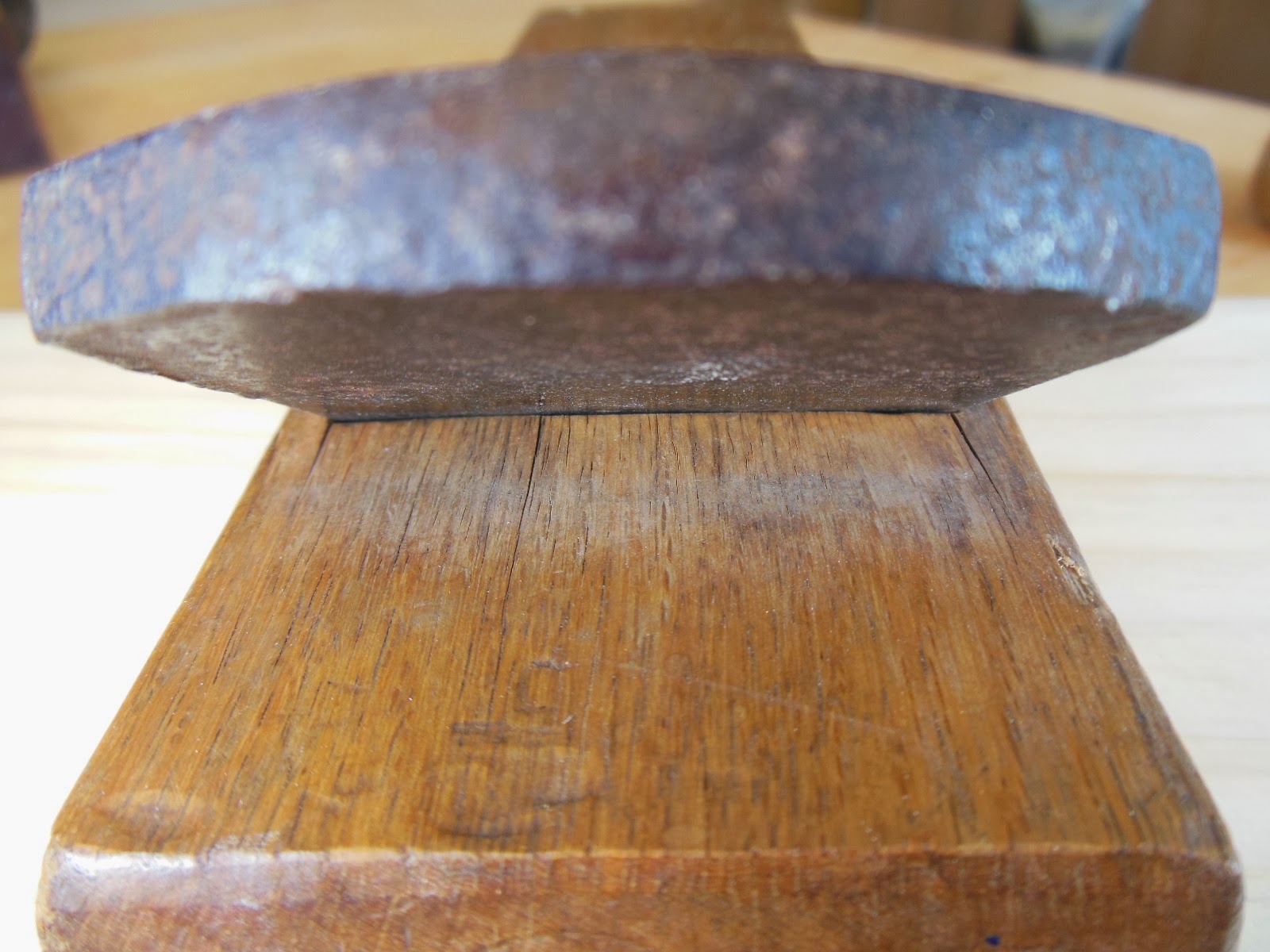Oh so many toys to play with, how do I choose? I am writing this real-time, as it were, and I am easily distracted. Sorry for the interruptions.
Right! Back to the kanna restoration...... Time to work on repairing and improving the body of the plane, the dai.
Not too bad. A bit of staining.....
.... and a decent sized incomplete crack on the sole. A very common ailment.
I pull the chip breaker retaining pin, the osae-bo. It goes in from left => right and is often.....a nail.
The crack, the crack.... how to address this problem?
Seen from the back, it's pretty small and about 24mm deep. Initially I thought to open the crack just a bit, using a saw, then to fit a sliver of new wood, but that seemed a bit sloppy. If the repair will be visible, at least it should look clean.
The crack ran at a slightly oblique angle and wandered a bit. Better to just take a big slice and resect all of the offending area.
I will fit a new piece with wood of a similar density. I thought about using Japanese oak, but decided on some interesting Peruvian walnut (best guess) that would give a pleasing contrast to the repair.
Stick it with hot hide glue. For really small jobs like this, I just heat a small portion using a heat gun. No need to fire up the ol' pot.
Squishy.
I flatten the sole, sandpaper on glass, 220 grit. The most important areas are marked with pencil. Sand the marks away. The mounted glass ensures that the sole will be in-plane. Flat.
Over the years, the dai has shrunk around the blade, resulting in some minor cracks and a slight bulge around the midsection. Ahhhhh, middle age.... Is this what's known as mid-line drift?
I forgot to take a photo, but whenever I find a small crack, like those on either side of the blade, I give them a shot of Super-glue. The low viscosity glue wicks into the crack better than any other glue and might help stabilize things for the future. This is a user-tool, remember.
A few swipes with a different plane will make this bulge a memory. Make the sides square to the bottom and the top square to the sides.
Squares-ville, man!
Just to be on the safe side, I fix a transverse pin of Peruvian walnut, right through the area prone to cracking. I think that this looks better than the usual steel machine screw/bolt. I use hide glue again.
Making the kanna square left clean, smooth surfaces. There is still the remnant of that stain on the starboard side, however. I don't know what caused it, biological or chemical. I'll try using some phosphoric acid to bleach the stain, it's not as harsh as bleach.
One of the reasons that I chose a contrasting wood for the repair, was that I am fitting an adjustable mouth insert, a kuchi-ire. It is fitted using a very tight, sliding dovetail joint, and will be fixed in place by a machine screw, allowing future adjustment.
A different mystery wood. Purple/reddish in color (not purple-heart though) with a very nice, tight, even grain, hard and the slightest bit oily. It also looks and smells like prosciutto! My daughter and I call it "Ham-wood".
Tap the insert down, until it's right where I want it....
.... then plane off the protruding portion.
Clean, no?
Haha! Ummmmm....... kinda flashy. It remind me of the Krenov style planes that I made decades ago. Interesting, but I'm not sure how I feel about this look. AND, it looks..... backwards.
I have been rounding the heads of my kanna, to present a striking surface and to prevent future deformation, but this is another one of those things..... In my mind, an old shokunin tightens his eyes, Hmm..... My conservative sensibilities are mildly offended.
Time to wrap this up. Time to fit the blade!
Now it's MY turn to tighten my eyes...... Hmm. Crap. Crap. Crap. Something is NOT right. I can still hear the echo.......
"I check the way that the blade fits in the body of the plane. Is it square, or does the blade tilt. Does the edge protrude on one side more than the other? In this case, the blade doesn't protrude at all, so I make everything square. THINK AND CHECK FIRST! Your kanna might have been built out-of-square, and if you just automatically make everything even and square, the blade won't fit right. Sometimes the edge of the blade isn't perpendicular to the primary axis because of careless sharpening, but sometimes it is intentional. Don't assume that the last guy was a fool!"
Hahahahahaha..... Who's the fool, NOW, fool?
Yet another perfect example of Murphy and his strange sense of humor. A simple kanna restoration, my ass. This will take some thought.


















No comments:
Post a Comment
Like all of us, I am figuring this out as I go, so when you see something that is incorrect or flat out wrong (and you will!), let me know. This is a learning process. Real people and names, please. Constructive comments and questions are very welcome, but hate speak/politics are not! Life (get one!) is too short.
Thanks, Jason